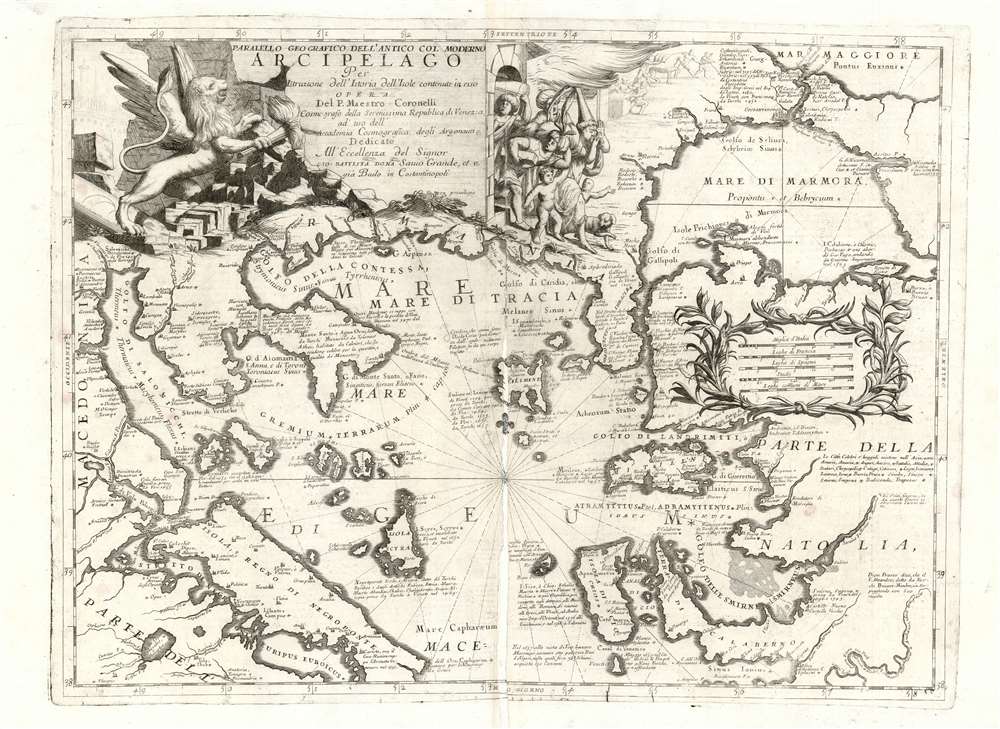This item has been sold, but you can get on the Waitlist to be notified if another example becomes available, or purchase a digital scan.
1697 Coronelli Map of the Northern Aegean Sea and the Bosporus
GreekIslands-coronelli-1697
Title
1697 (undated) 17.75 x 23.5 in (45.085 x 59.69 cm) 1 : 1400000
Description
A Fierce Triumphal Cartouche
Many of Coronelli’s maps boast ornate allegorical cartouches, and this one is no exception. The winged Lion of Venice appears at left, roaring and smashing down a wall, brandishing a lit torch in his right paw to set the structure afire. Meanwhile, to the right, a dismayed crowd of dogs, putti, and be-turbaned and pointy-hatted Turks spill out of the burning building, fleeing with whatever they can carry. The context for the warlike cartouche is the Sixth Ottoman-Venetian War (1684 - 1699), also known as the Morean War. The beginning of the war was characterized by a successful Venetian offensive that brought the capture of fortresses in western Greece, the Peloponnese, and a brief (and destructive) occupation of Athens. Although an Ottoman counteroffensive began in 1688 that would reverse many of the Venetian successes, on balance this stands out of the only one of the Ottoman-Venetian wars that can be counted a Venetian triumph. Certainly, at the time this map was executed, it must have seemed so: by 1718 the tables would be turned yet again.Census and Publication History
This map appeared in editions of Coronelli’s Corso Geografico Universale in 1690 but was also included in the second volume of his Atlante Veneto. in 1696. The presence of verso text indicates that this example is from this latter work. The map is only catalogued separately by the Bibliotheque Nationale, the Bayerische Staatsbibliothek, and the Biblioteca Nacional de Espana. The Atlante Veneto is well represented in institutional collections.Cartographer
Vincenzo Maria Coronelli (August 16, 1650 - December 9, 1718) was an important 17th-century cartographer and globe maker based in Venice. Coronelli was born the fifth child of a Venetian tailor. Unlikely to inherit his father's business, he instead apprenticed in Ravenna to a woodcut artist. Around 1663, Coronelli joined the Franciscan Order and, in 1671, entered the Venetian convent of Saint Maria Gloriosa dei Frari. Coronelli excelled in the fields of cosmography, mathematics, and geography. Although his works include the phenomenal Atlante Veneto and Corso Geografico, Coronelli is best known for his globes. In 1678, Coronelli was commissioned to make his first major globes by Ranuccio II Farnese, Duke of Parma. Each superbly engraved globe was five feet in diameter. Louis IV of France, having heard of the magnificent Parma globes, invited Coronelli to Paris, where from 1681-83 he constructed an even more impressive pair of globes measuring over 12 feet in diameter and weighing 2 tons each. The globes earned him the patronage of Louis XIV and privileged access to French cartographic information from Jesuit sources in the New World, particularly Louisiana. Coronelli returned to Venice and continued to publish globes, maps, and atlases, which were admired all over Europe for their beauty, accuracy, and detail. He had a particular fascination for the Great Lakes region, and his early maps of this area were unsurpassed in accuracy for nearly 100 years after their initial publication. He is also well known for his groundbreaking publication of the first accurate map depicting the sources of the Blue Nile. At the height of his career, Coronelli founded the world's first geographical society, the Accademia Cosmografica degli Argonauti, and was awarded the official title Cosmographer of the Republic of Venice. In 1699, in recognition of his extraordinary accomplishment and scholarship, Coronelli was also appointed Father General of the Franciscan Order. The great cartographer and globe maker died in Venice at the age of 68. His extraordinary globes can be seen today at the Bibliothèque Nationale François Mitterrand in Paris, Biblioteca Marciana in Venice, the National Library of Austria, the Globe Museum in Vienna, the Library of Stift Melk, the Special Collections Library of Texas Tech University, as well as lesser works in Trier, Prague, London, and Washington D.C. Coronelli's work is notable for its distinctive style, which is characterized by the high-quality white paper, dark intense impressions, detailed renderings of topographical features in profile, and numerous cartographic innovations. More by this mapmaker...

